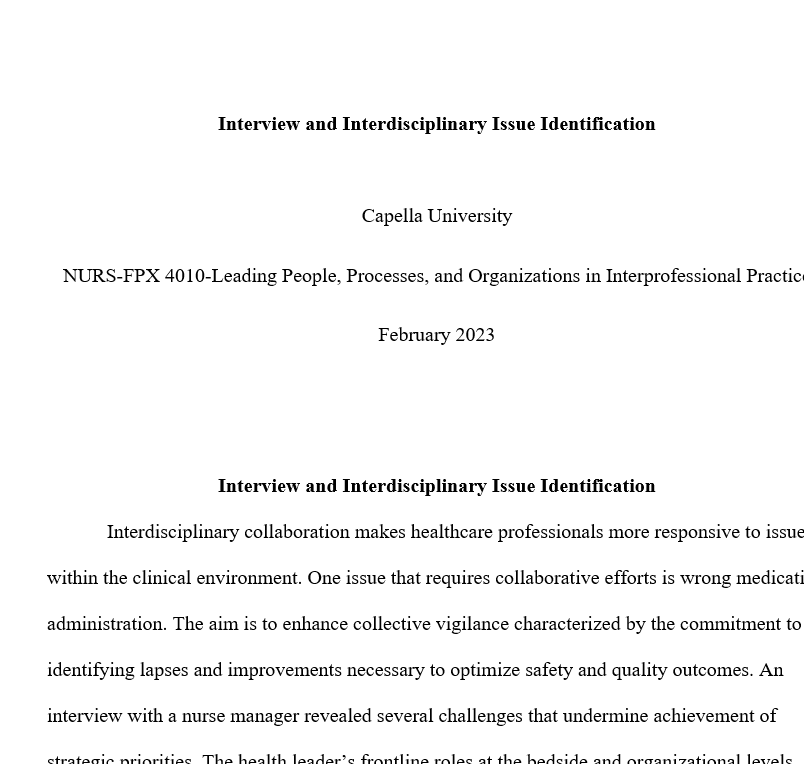NURS-FPX4010_TS_Assessment 2-1 solution.docx
Interview and Interdisciplinary Issue Identification
Capella University
NURS-FPX 4010-Leading People, Processes, and Organizations in Interprofessional Practice
February 2023
Interview and Interdisciplinary Issue Identification
Interdisciplinary collaboration makes healthcare professionals more responsive to issues within the clinical environment. One issue that requires collaborative efforts is wrong medication administration. The aim is to enhance collective vigilance characterized by the commitment to identifying lapses and improvements necessary to optimize safety and quality outcomes.
An interview with a nurse manager revealed several challenges that undermine achievement of strategic priorities. The health leader’s frontline roles at the bedside and organizational levels make her aware of the various lapses within the clinical environment and measures available to ensure that patients receive the best services across the continuum.
The nurse manager plays multiple roles including, managing the nursing team, budgeting, recruiting new staff, and responding to administrative, technical, and human-related trends within the healthcare system.
A qualitative session using a semi-structured questionnaire enabled the interviewee to clarify the different issues including, leadership barriers, resistance to change associated with new technologies, and a changing workforce demography. The nurse manager expressed concerns over changing patient demands including, the need for the care team to respond to demands of clients in remote locations.
The Issue
The interview revealed several concerns within the clinical setting. A dominant issue expressed by the nurse manager was worrying rates of medication errors. For instance, wrong medication administration exposes patients to adverse drug reactions, readmissions, prolonged hospitalization, and premature death (Manias, 2018).
For healthcare providers, medication errors trigger reputational loss and additional cost of care. Nurses, physicians, pharmacists, and others are vulnerable to lawsuits, revocation of license, and termination of employment. Interdisciplinary collaboration is a priority for the care team to make informed decisions about pathways for enhancing the quality and safety of patient care (Hussain et al., 2018).
This way, physicians, nurses, and pharmacists should dedicate themselves towards identifying and intercepting risks likely to trigger medication errors. Health leaders should initiate educational sessions and briefings to make the care team aware of the need for collaborative efforts to safeguard patients from undesirable outcomes.
Change Management and Leadership
Successful outcomes depend on the quality of leadership. The right leader creates a conducive environment that allows everyone to share information about lapses associated with wrong medication administration. The leader initiates change processes guided by the use of theories such as the Plan-Do-Study-Act (PDSA) cycle. The model enables leaders to develop an action-oriented framework characterized by collective buy-in and resilience towards enhancing the safety of patient care.
McNicholas et al. (2019) emphasized the need for health leaders to initiate systematic procedures guided by individual and collective involvement in planning, testing, observing results, and using the lessons to achieve the intended improvements.
Everyone understands complexities of the healthcare system and measures appropriate for sustaining excellent communication, mutual-trust, and task prioritization (Nilsen et al., 2020). Further, the right leader utilizes feedback from clinical rounds, staff meetings, training, and conversations with nurses, physicians, and others. The feedback paves way for informed decisions about interventions needed to overcome wrong medication administration.
Interdisciplinary Collaboration
The interdisciplinary team has a nurse educator, nurses, physicians, the nurse manager, and clinical assistants. The group has frontline experiences at the bedside and organizational levels that enable them to discuss lapses and improvements appropriate for improving care delivery (Manias, 2018).
The team will participate in briefings on incidents involving wrong medication administration. The nurse educator will design role plays, share checklists on collaborative vigilance, and use video simulations to make everyone aware about their roles and responsibilities in monitoring and preventing medication errors.
Conclusion
Encouraging team-based values, beliefs, and attitudes is a priority for organizations dedicated to sustaining quality, safe, and cost-effective service delivery. Wrong medication administration is among the issues that remind healthcare providers about the need for interdisciplinary collaboration. Nurses, physicians, and clinical assistants acknowledge their roles in enhancing collective vigilance to intercept and prevent medication errors.
References
Hussain, S. T., Lei, S., Akram, T., Haider, M. J., Hussain, S. H., & Ali, M. (2018). Kurt Lewin’s change model: A critical review of the role of leadership and employee involvement in organizational change. Journal of Innovation and Knowledge, 3(3), 123-127. https://www.sciencedirect.com/science/article/pii/S2444569X16300087
Manias, E. (2018). Effects of interdisciplinary collaboration in hospitals on medication errors: An integrative review. Expert Opinion on Drug Safety, 17(3), 259-275. https://pubmed.ncbi.nlm.nih.gov/29303376/
McNicholas, C., Lennox, L., Woodcock, T., Bell, D., & Reed, J. E. (2019). Evolving quality improvement support strategies to improve plan–do–study–act cycle fidelity: A retrospective mixed-methods study. BMJ Quality & Safety, 28(5), 356–365. https://pubmed.ncbi.nlm.nih.gov/30886118/
Nilsen, P., Seing, I., Ericsson, C., Birken, S., & Schildmeijer, K. (2020). Characteristics of successful changes in health care organizations: An interview study with physicians, registered nurses and assistant nurses. BMC Health Services Research, 20(147), 1-8. https://bmchealthservres.biomedcentral.com/articles/10.1186/s12913-020-4999-8
Berdot, S., & Sabatier, B. (2018). Medication errors may be reduced by double-checking method. Evidence-Based Nursing, 21(3), 67-67. https://hal.archives-ouvertes.fr/hal-03335317/file/Berdot%20double%20check%202018.full.pdf
Hussain, S. T., Lei, S., Akram, T., Haider, M. J., Hussain, S. H., & Ali, M. (2018). Kurt Lewin’s change model: A critical review of the role of leadership and employee involvement in organizational change. Journal of Innovation and Knowledge, 3(3), 123-127. https://www.sciencedirect.com/science/article/pii/S2444569X16300087
Kim, M. S., Seok, J. H., Kim, B. M. (2020). Mediating role of the perceived benefits of using a medication safety system in the relationship between transformational leadership and the medication-error management climate. Journal of Research in Nursing, 25(1), 22-34. https://journals.sagepub.com/doi/pdf/10.1177/1744987118824621
Manias, E. (2018). Effects of interdisciplinary collaboration in hospitals on medication errors: An integrative review. Expert Opinion on Drug Safety, 17(3), 259-275. https://pubmed.ncbi.nlm.nih.gov/29303376/
McGowan, M., & Reid, B. (2018). Using the Plan, Do, Study, Act cycle to enhance a patient feedback system for older adults. British Journal of Nursing, 27(16), 936–941. https://pubmed.ncbi.nlm.nih.gov/30187794/
McNicholas, C., Lennox, L., Woodcock, T., Bell, D., & Reed, J. E. (2019). Evolving quality improvement support strategies to improve plan–do–study–act cycle fidelity: A retrospective mixed-methods study. BMJ Quality & Safety, 28(5), 356–365. https://pubmed.ncbi.nlm.nih.gov/30886118/
Nilsen, P., Seing, I., Ericsson, C., Birken, S., & Schildmeijer, K. (2020). Characteristics of successful changes in health care organizations: An interview study with physicians, registered nurses and assistant nurses. BMC Health Services Research, 20(147), 1-8. https://bmchealthservres.biomedcentral.com/articles/10.1186/s12913-020-4999-8



